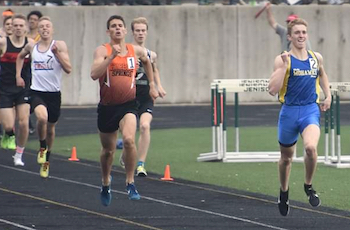
Track Champ Eager for Next Challenge
June 30, 2020
By Tom Kendra
Special for Second Half
Aiden McLaughlin’s high school run got cut short, so now it’s time for him to fly.
McLaughlin, who recently graduated from Morley Stanwood High School, was one of thousands of Michigan high school seniors who lost out on their final spring season due to the Covid-19 pandemic. That meant he never got to attempt to repeat his 2019 Division 3 Finals championship in the 800-meter run.
“That was definitely a major goal to try and defend that title,” said McLaughlin, who won that race at Zeeland Stadium with a time of 1:55.1. “But I was really looking forward to being with my teammates for my senior year – seeing how well we could do in our relays and things like that. That was more disappointing for me than the personal stuff.”
McLaughlin never slowed down throughout the lockdown this spring, instead using the time to get physically and mentally prepared for his next challenge. This week, he started his freshman year as a fourth class cadet at the U.S. Air Force Academy in Colorado.
He was on his way to a District basketball game in March when he learned that he had been accepted into the Air Force Academy, a nomination which has been a huge source of pride for the close-knit Morley community.
“We are all so happy for Aiden and can’t wait to see everything he does from here,” said Michele Young, who recently retired after 32 years of coaching track at Morley Stanwood. “He sets high expectations for himself, and he usually reaches them. He has the heart and mind and soul of a champion.”
 Young has coached some great athletes over her 32 years, including Travis McCuaig, who won back-to-back Division 3 Finals championships in the high jump in 2012 and 2013. However, Young said she has never coached a high school athlete as self-motivated and self-disciplined as McLaughlin.
Young has coached some great athletes over her 32 years, including Travis McCuaig, who won back-to-back Division 3 Finals championships in the high jump in 2012 and 2013. However, Young said she has never coached a high school athlete as self-motivated and self-disciplined as McLaughlin.
Not that she is entirely surprised.
Young coached both of his parents, Amanda (Bush) McLaughlin and Curtis McLaughlin, who were standout runners and high school sweethearts at Morley in the mid-1990s.
“They were both amazing athletes as well,” Young recalled. “Mandy was a distance runner and Curtis was more of a sprinter; he was very fast. I tell Aiden he is a combination of them. That’s why he can run anything from the 200 to the 2-mile.”
McLaughlin, who was also a four-time all-stater in cross country, excelled most in high school in the 800 meters and also has posted personal bests of 4:24.6 in the 1,600 and 52.3 in the 400.
Getting accepted into the Air Force Academy was a goal for McLaughlin since he attended a running camp there during the summer following his freshman year.
“I loved everything about it, and I made up my mind that I was going to do everything I could to get in there,” McLaughlin said.
McLaughlin put together quite an impressive resume over his four years of high school, notably earning all-state honors in all three of his sports: cross country, basketball and track. He was also a member of the school’s robotics team, National Honor Society and the Mecosta County Youth Advisory Committee. He waded through the lengthy process of applying to the Air Force Academy; he was nominated by John Moolenaar, the representative of Michigan’s 4th Congressional District in the U.S. House of Representatives.
While most people go to the Air Force to fly, the 18-year-old McLaughlin is going there to run – at least at first. He will compete on the indoor and outdoor track teams, while pursuing a degree in aerospace engineering or astronomical engineering.
McLaughlin said he is nervous and excited, “but definitely more excited than nervous.”
“I like anything that’s a challenge to me,” McLaughlin explained. “Honestly, my biggest goal right now is just to graduate from the Air Force Academy. I know if I do that, I will have a lot of opportunities.”
PHOTOS: (Top) Morley Stanwood’s Aiden McLaughlin will continue his academic and running careers at the U.S. Air Force Academy. (Middle) McLaughlin breaks away during the 2019 Lower Peninsula Division 3 Finals 800-meter run. (Photos courtesy of Morley Stanwood athletics.)

Track Gaining Speed Toward Future with Electronic Starting Devices
By
Steve Vedder
Special for MHSAA.com
May 23, 2023
Aubrey Greenfield thinks it might be the perfect time to reevaluate 130 years of tradition.
For a number of reasons, from technical to personal, the Oxford senior sprinter believes it makes sense for the crack of a starting pistol to be eliminated from high school track meets.
Because track meets would benefit in various ways from lowering costs to easier setup at meets to the human factor of competitors not having to flinch at the crack of a pistol shot, Greenfield believes the sport has a chance to embrace new technology – electronic starting devices (ESD).
In essence, an ESD replaces the starting pistol with a light flash, tone sound or both to begin a race.
"High school sports should put the athlete first," Greenfield said. "We should promote sports, and eliminating starting pistols promotes health in terms of PTSD or trauma for athletes and spectators and that would be good. I would like to think people would say that's a good idea."
In fact, Greenfield would go as far as to say if there was not an implementation of electronic starting devices, many of her teammates would have considered giving up the sport.
"If it's something that helps us compete safely, we're all for it," she said.
Greenfield's opinion apparently is spreading. Michigan High School Athletic Association senior assistant director Cody Inglis said the use of ESD makes it both affordable for meet starters and sensible for athletes and fans to rethink the use of starting pistols. While the MHSAA is not mandating electronic starting devices, it does promote the use of what Inglis calls "emerging technology." He notes that ESD are becoming the norm for organizations such as USA Track & Field, the NCAA and an increasing number of high schools.
 "I think we have to embrace new technology, and we think this will be something that takes hold," Inglis said.
"I think we have to embrace new technology, and we think this will be something that takes hold," Inglis said.
A key part of embracing ESD is the human element. The tragic Oxford High School shooting Nov. 30, 2021, that took the lives of four students while injuring seven others should not be relived even for a fleeting instance at a high school sporting event. Oxford athletic director Tony DeMare said the school began using ESD at every meet, including the MHSAA Lower Peninsula Division 1 Finals last June. He said that decision was embraced by virtually all schools Oxford encountered.
"We were very convinced that the alternative (of ESD) would promote a healthy attitude," DeMare said. "We were overwhelmed with the positive response. If a school was on the fence about it or might not be for it, I think we've started to see the tide turn in favor of people willing to listen and learn about electronic starting devices."
Inglis said the MHSAA is acutely aware of what the crack of a starting pistol can mean to athletes and fans.
"It's unimaginable what Oxford went through, and this is a small way we can help," he said. "We look at a (starting pistol) and think, ‘Could we do something else?’ It's a way of helping to solve a problem."
Over the last several years, the MHSAA has embraced finding an alternative to starting pistols. Inglis noted the discussion started with the cost and diminishing availability of 32-caliber ammunition that meet starters use. A box of ammunition, if it can be found, is around $75 a box.
In addition to cost, there is potential damage from excessive exposure to 150-plus decibels of sound generated by the traditional 32-caliber blanks. Medical studies show damage to ears caused by decibel levels above 120 dB.
The tragedy at Oxford accelerated the conversation.
Inglis said the cost of ESD can be likened to a school sinking money into artificial surfaces at football fields. Yes, there is a great cost at first, but over time money is ultimately saved. An ESD system itself ranges between $200 and $500. Speakers also may need to be purchased, but with ESD starting events like the 800 and 1,600-meter relays positioned near the outside lanes 8, 7, 6 and 5 would result in improved hearing by athletes at the start of a race.
There is one challenge with ESD that track administrators are working to overcome – lighting conditions that lessen the ability to see the ESD’s LED light or strobe when the button is pressed by a starter to begin a race. But that vision difficulty resulting from clear blue skies and backgrounds of setting suns can be substantially improved by incorporating a black background with an ESD – something as simple as a starter holding up black cardboard behind the lighting mechanism at the start of an event.
Inglis said when all factors are considered, the use of ESD makes sense.
 "With the climate we live in nowadays, no lookalike guns is good," he said. "We're not mandating this. But people are saying this is affordable."
"With the climate we live in nowadays, no lookalike guns is good," he said. "We're not mandating this. But people are saying this is affordable."
While switching to ESD would break 130 years of tradition, the timing could be a step forward, said Jeff Hollobaugh, co-author of the book "The Fleet Feet of Spring: Michigan's High School State Championships in Track & Field." He said while no definitive answer is possible, it's likely starting pistols were used at the inaugural state meet at the Jackson Fairgounds in 1895. The meet, which included events like tossing a 16-pound shot put, bike races and a 100-meter sprint, was sponsored by the Michigan Interscholastic Athletic Association (a predecessor to the MHSAA) and comprised mostly of the state's larger schools.
Hollobaugh's sentiments echo what many involved in today's high school track & field believe in terms of making a transition from starting pistols to electronic starting devices.
"It's a change, not necessarily good or bad, just different," he said. "It's not a drastic change, but it will take some getting used to. But it is the future. In the end, we'll all be fine."
DeMare believes the future of high school track will definitely include ESD.
"Our desire is that the practicality and sensibility of this will overcome the alternative," he said. "I think we'll see the automation and electronics taking hold of certain elements in track, and people will embrace it."
PHOTOS (Top) Runners watch official Bertha Smiley as they prepare to begin a race during last season's Lower Peninsula Division 1 Finals at Rockford. (Middle) An electronic starting device provided by VS Athletics was used to start those races. (Below) Smiley sets to begin an event. (Photos provided by David Kuderka/VS Athletics.)

